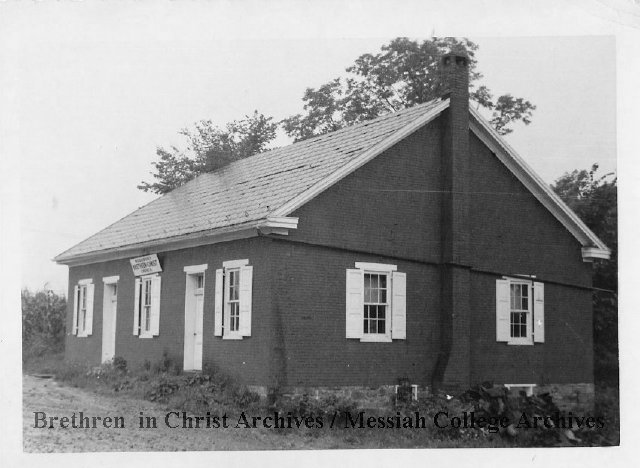
Today’s Photo Friday post showcases a photo of one of the first meetinghouses ever built by the Brethren in Christ Church — a structure that emerged during a tense period of conflict and controversy in the church’s history.
Faithful readers of The Search for Piety and Obedience will know that we’ve written frequently about the fact that for the first century of their existence, the Brethren in Christ did not build meetinghouses. Instead, members met and worshiped in one another’s homes and barns, reflecting the family-like nature of the church in its earliest years.
But did you know that one of the church’s mid-nineteenth-century schisms centered on the building of a meetinghouse, considered too “worldly” by church authorities of the day?
As Brethren in Christ historian Carlton O. Wittlinger records in his magisterial history, Quest for Piety and Obedience:
The immediate cause of the schism was the decision of Matthias Brinser and his Dauphin County followers to build a small meetinghouse near Middletown, Pennsylvania. An increasing Brethren membership in that locality was outgrowing the capacity of homes to accommodate the worship services. . . .
Simple as this meetinghouse was, it aroused a storm of opposition especially among the Lancaster County Brethren. . . .
Wittlinger also describes how, during one council meeting held on a stormy winter night, church members debated for hours over what to do about Brinser’s planned violation of church custom. In the end, they prepared a sharply-worded admonition to Brinser, urging him not to continue his project. Nevertheless, the ambitious Brinser — a “colorful” bishop in the Dauphin County area, according to Wittlinger — moved ahead with his plans.
Wittlinger continues the story:
The result was that the meetinghouse controversy reached a climax in the summer of 1855 with the [Brethren in Christ] excommunication of Matthias Brinser and all of his supporters. . . . [The] excommunication seems to have fixed a point of no return for [Brinser’s] group. Referring to that action, Brinser reportedly remarked: . . . ‘They will sometime eat what they now vomit.’ . . . He could not, of course, have foreseen how soon this prophecy would be fulfilled. Within the next decade . . . meetinghouses appeared at Woodbury, Pennsylvania, and near Canton, Ohio. Early in the 1870s the Franklin County Brethren began to build them, and they soon became commonplace even in Lancaster County.
The so-called “Brinserites” eventually formed their own separate denomination, the United Zion’s Children (now United Zion Church). In later years, the Brethren in Christ and the United Zion explored the possibility of merger, although those plans were eventually scrapped.
Nevertheless, today’s photo is a living testament to Brinser’s provocative prophecy — and, perhaps, a cautionary tale about how to treat innovators in the life of the church.
